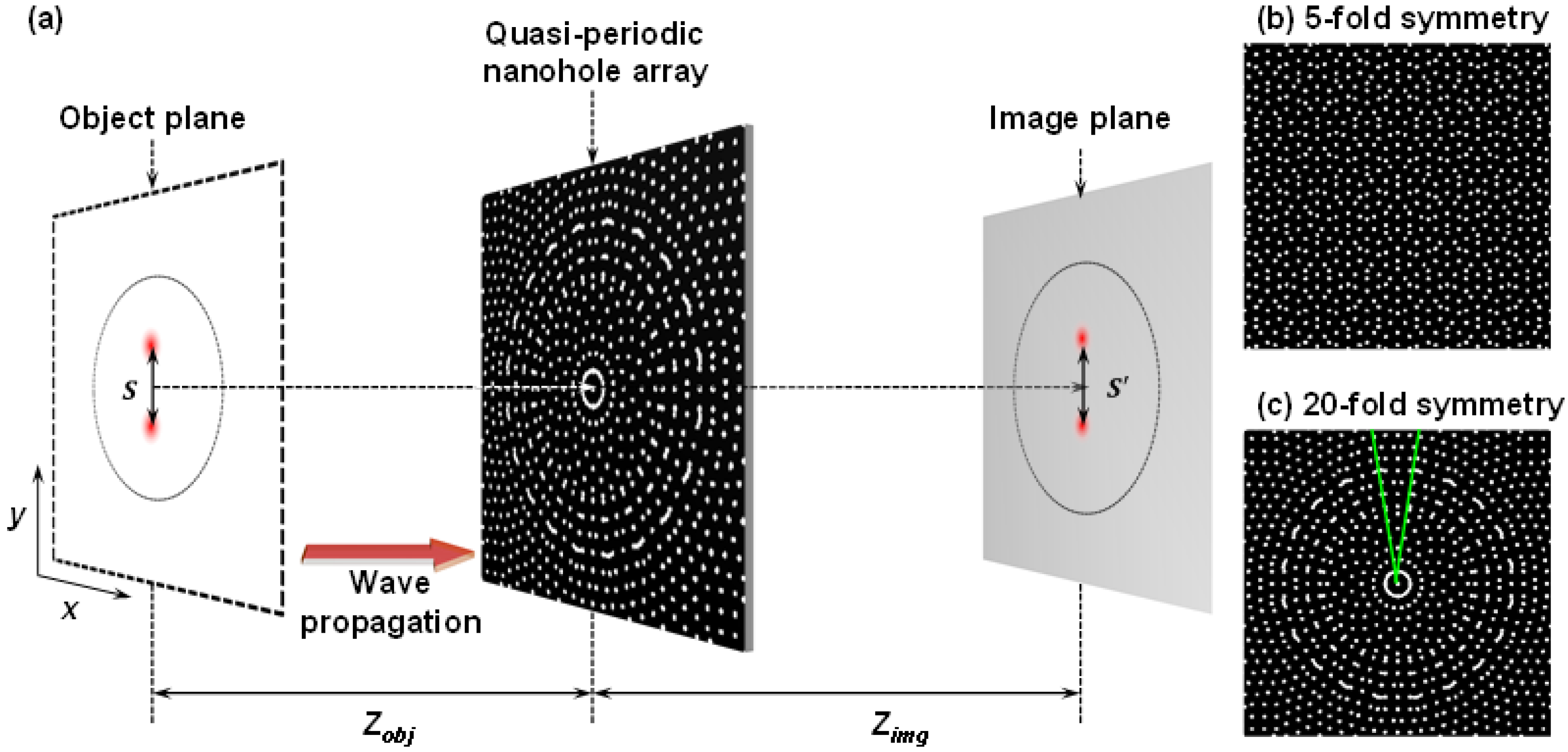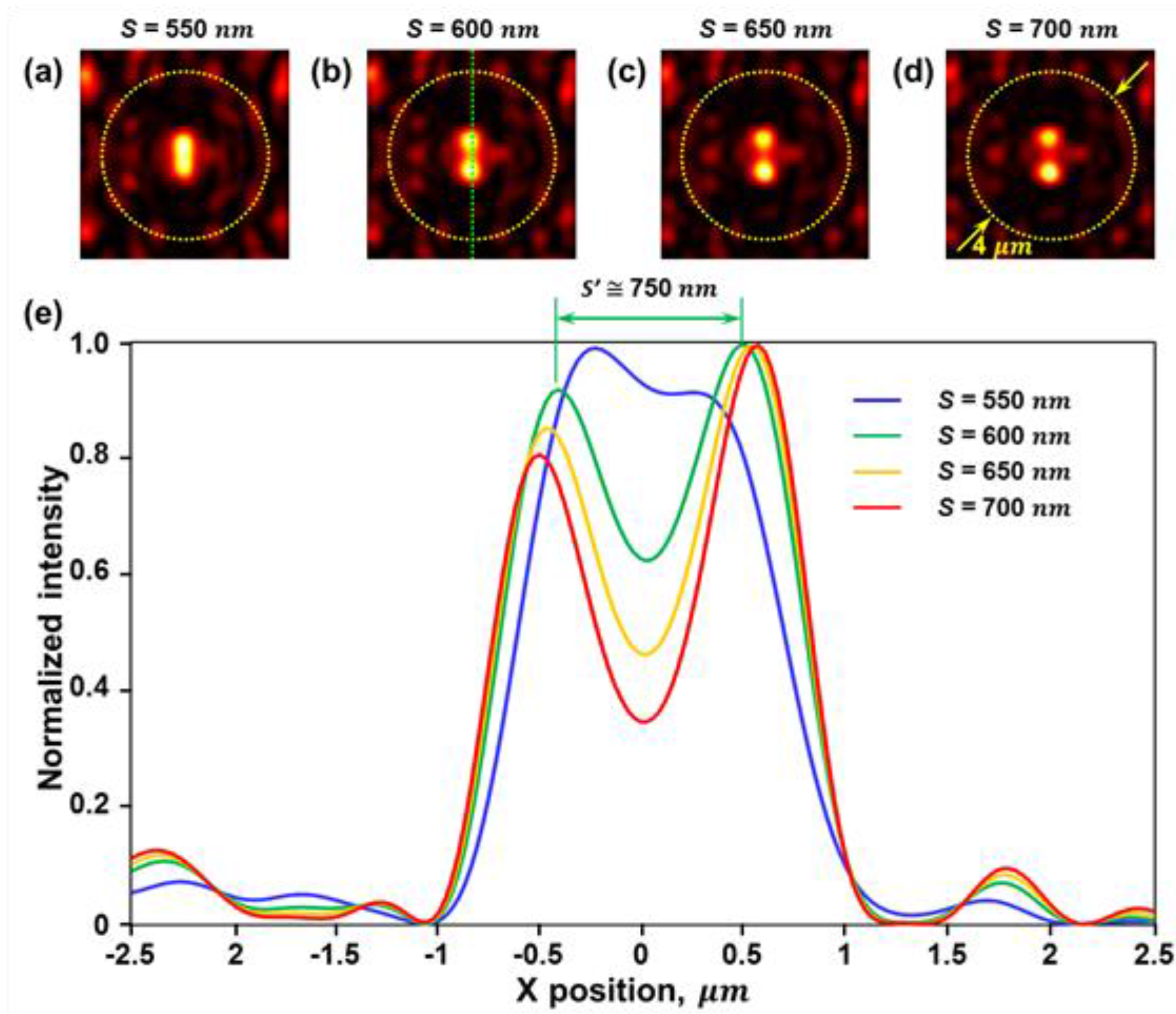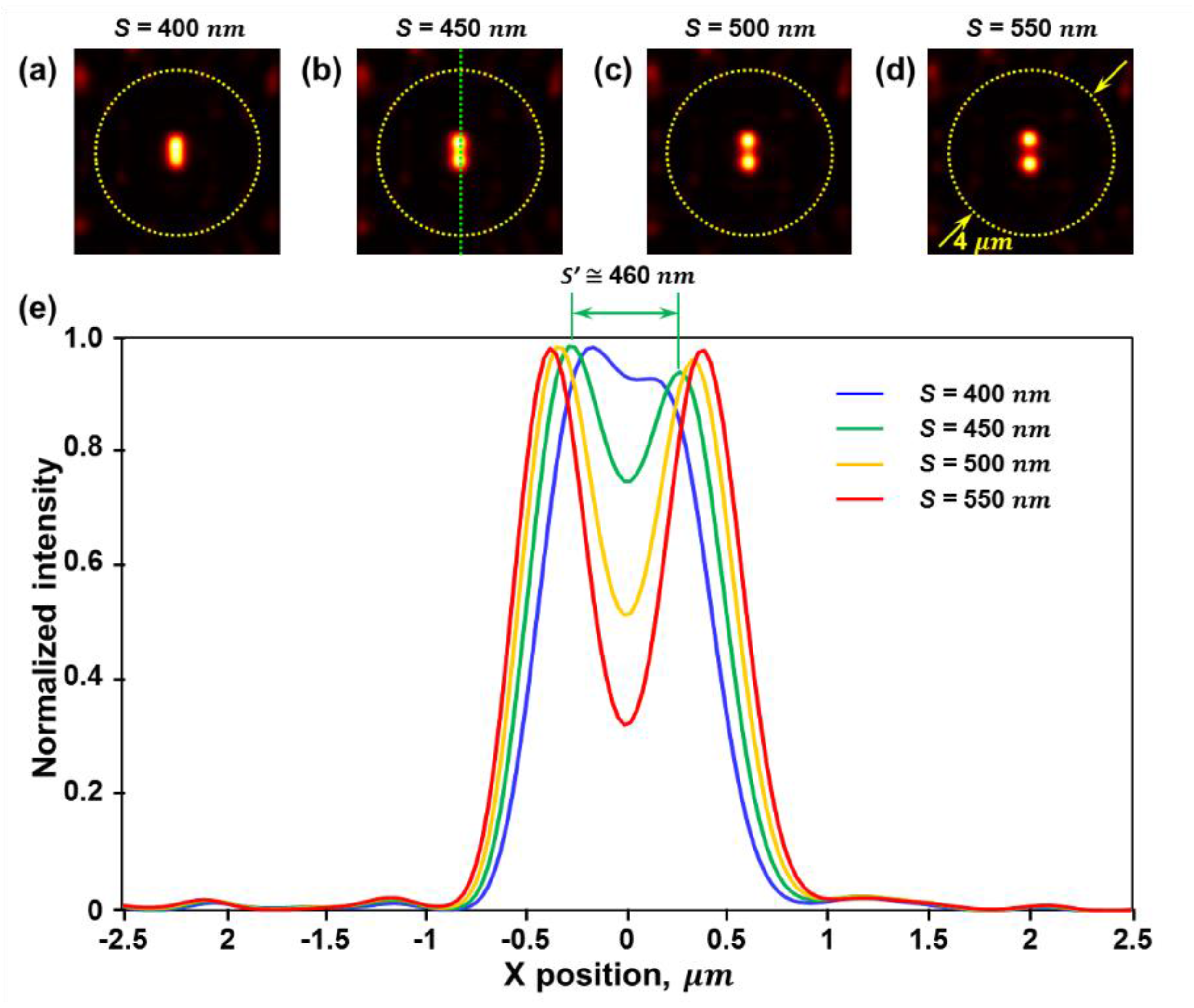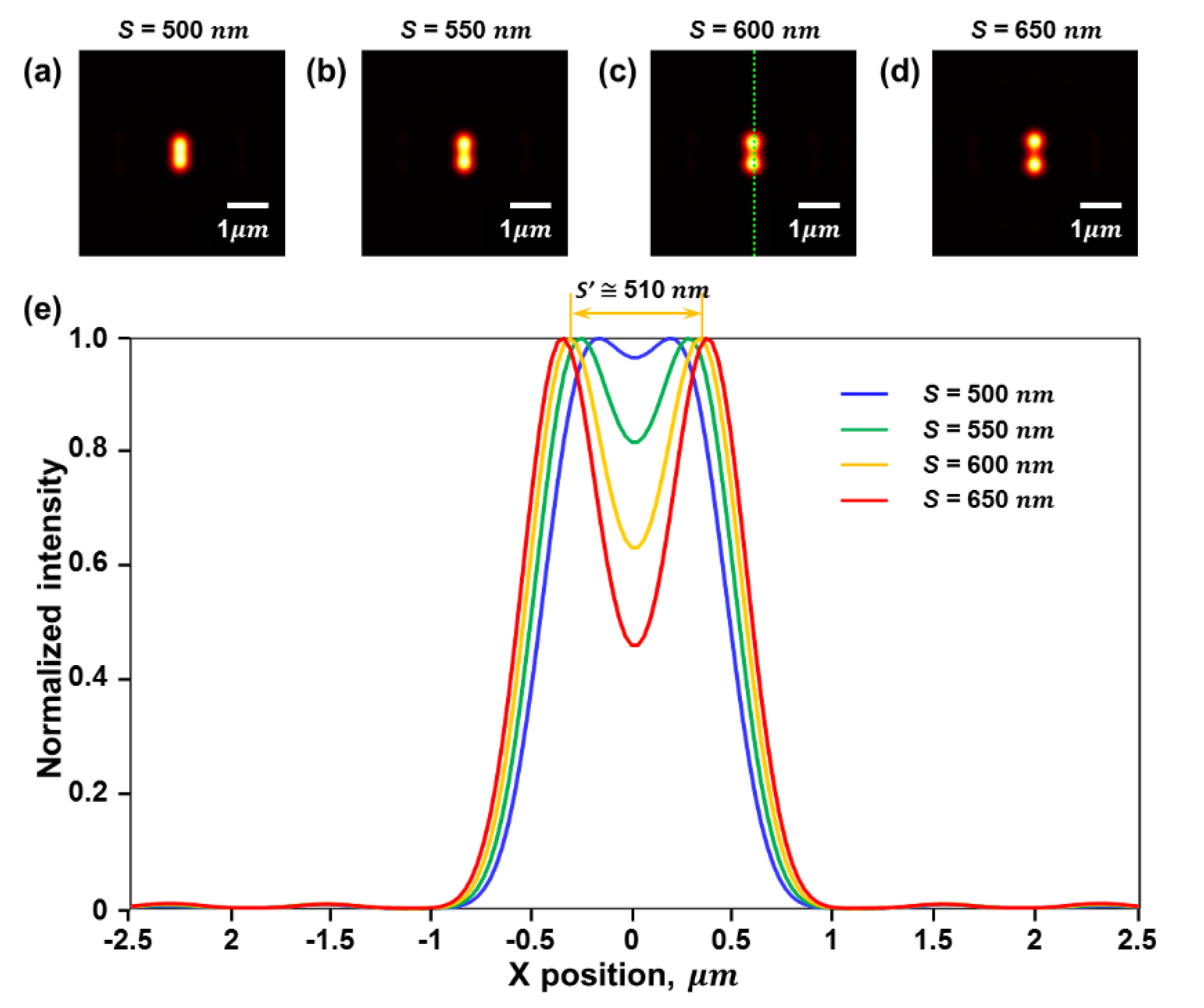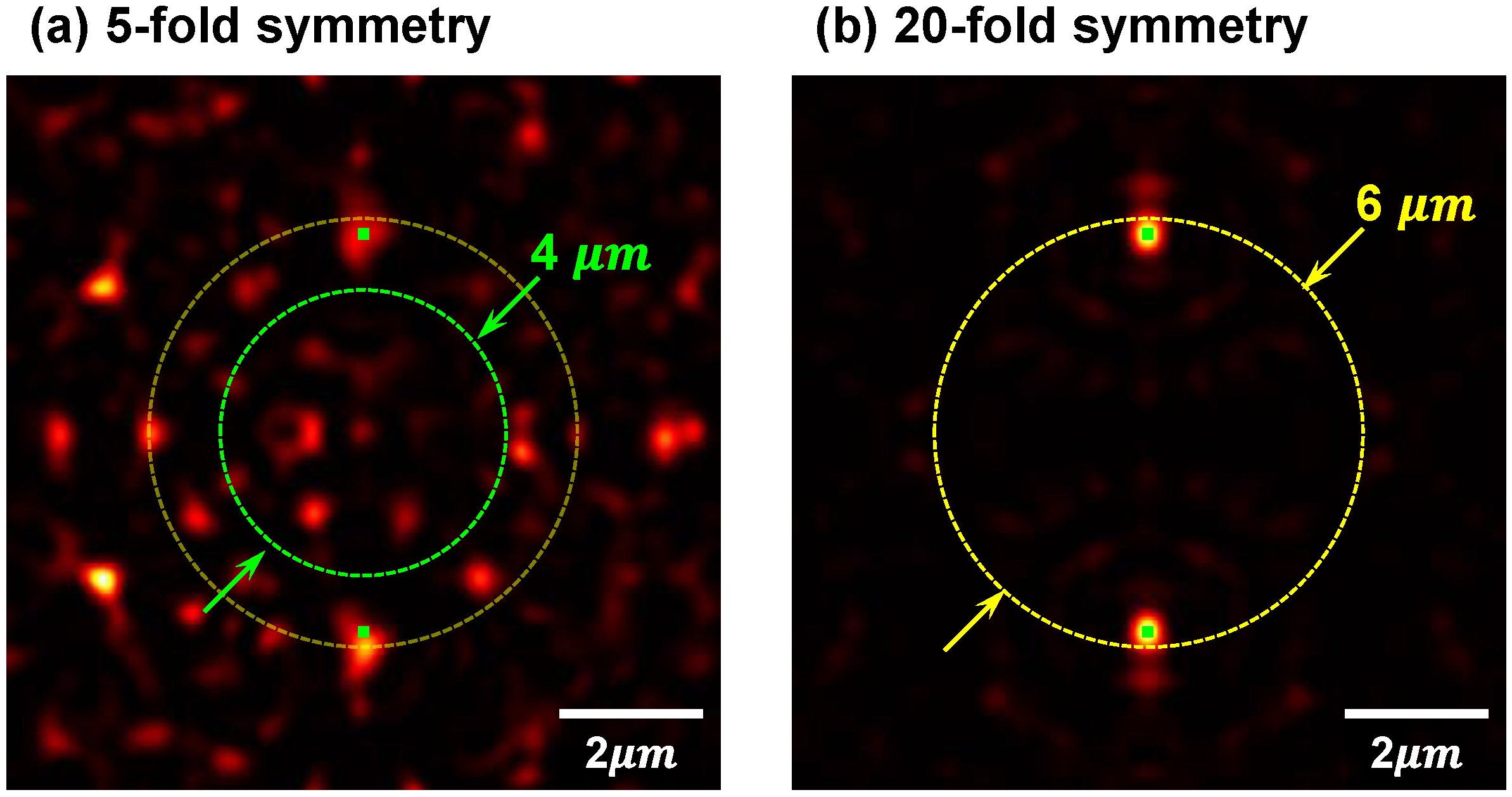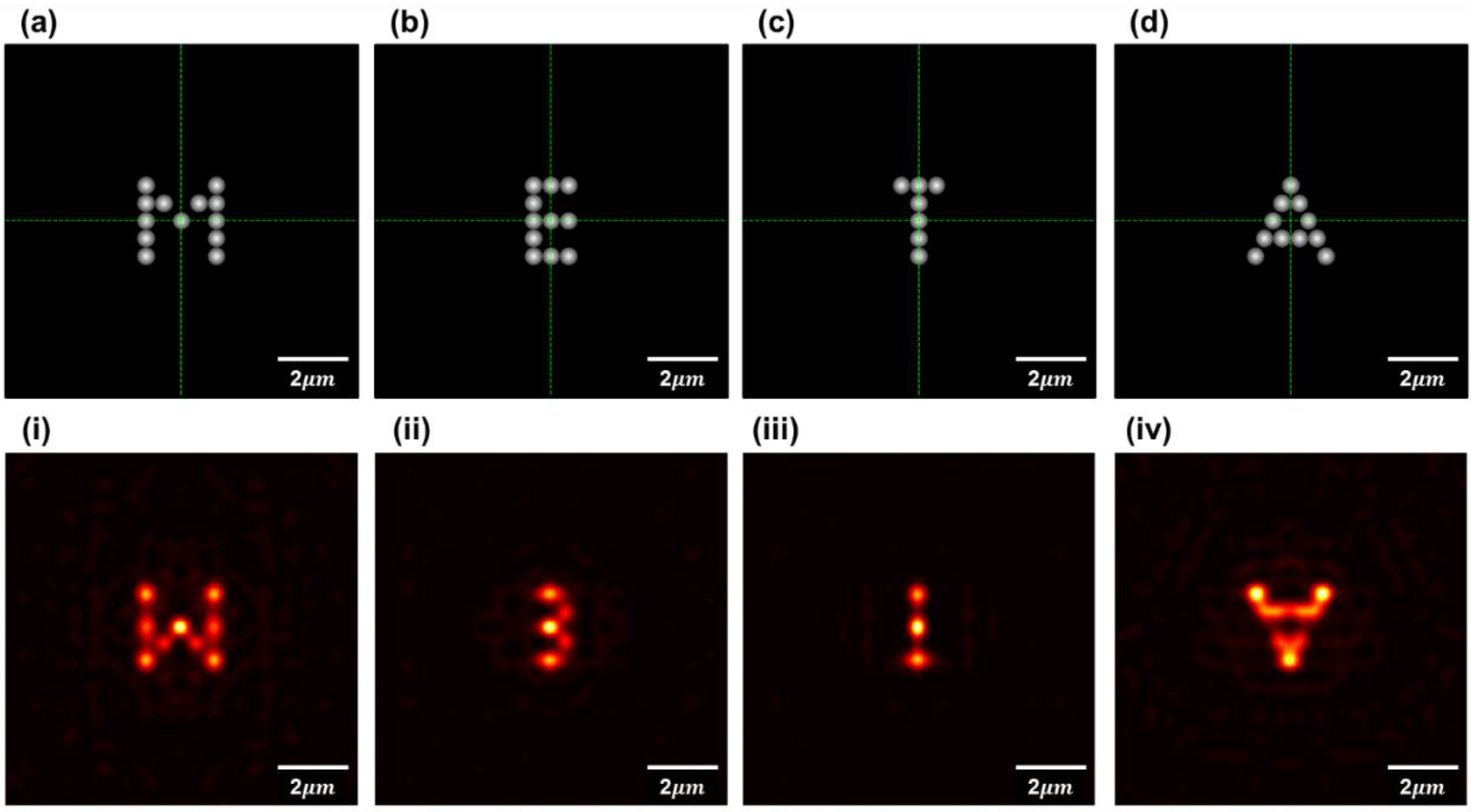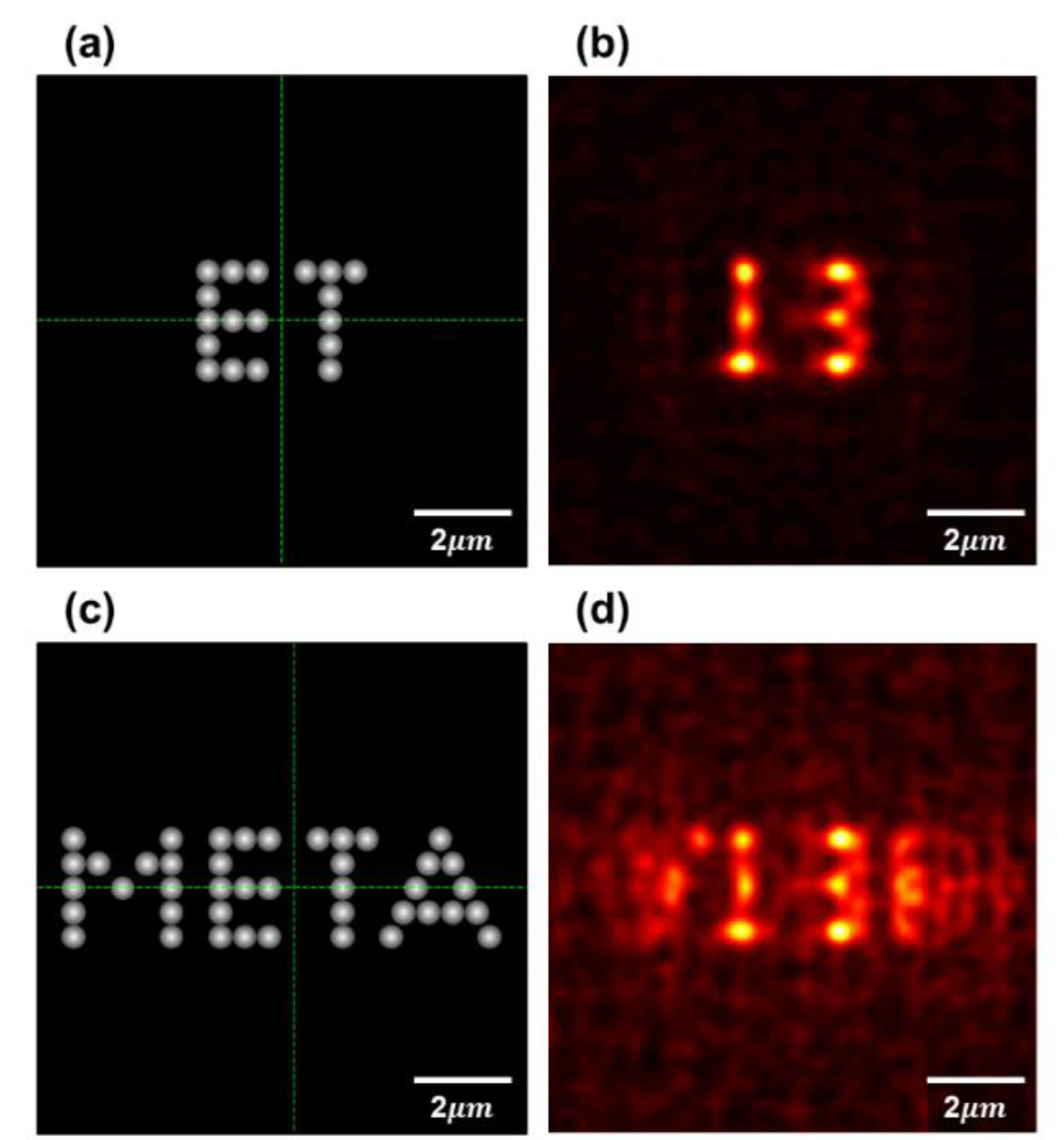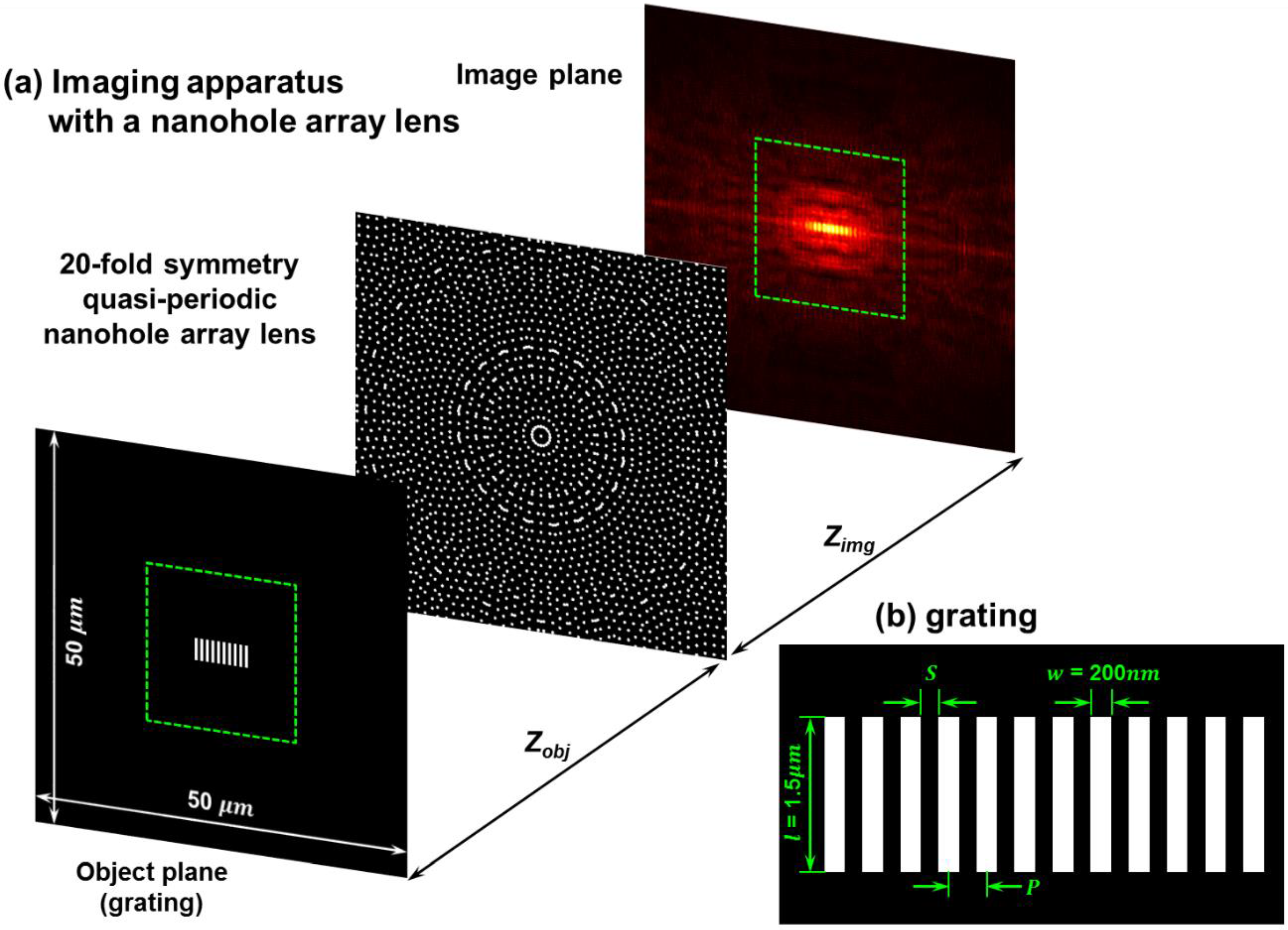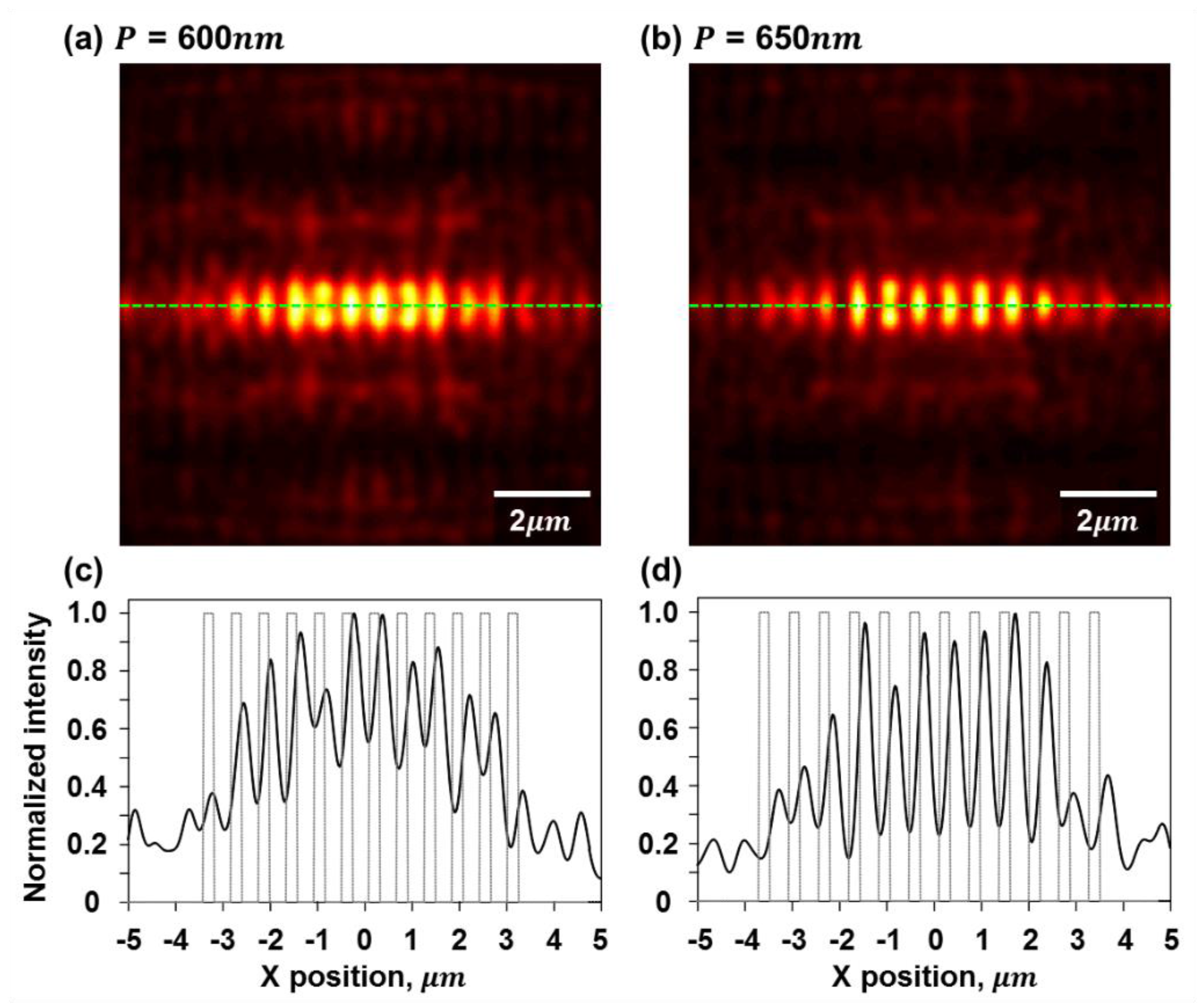2. Imaging Abilities of a Nanohole Array Lens: Point Light Sources Illumination
To demonstrate and compare the lensing functions of quasi-periodic nanohole arrays, a calculation model of the imaging apparatus is schematically shown in
Figure 1a. Optical sources with a separation
S are placed on an object plane at a distance of Z
obj away from a nanohole array lens. The size of nanohole array lenses in the calculations is in an area of 50 × 50 μm
2, while the illumination wavelength of the point sources is λ = 660 nm. In calculations, the scalar angular spectrum method is used to first calculate field intensity distribution on the nanohole array surface from light illuminations on the object plane [
23,
24]. The calculations are based on the diffraction theory employing the angular spectrum representation of the diffracted field. The diffracted field distribution at a distance Z
obj away from the object plane’s surface can be expressed as:
where
κ is the wavevector of light and
F(κ
x, κ
y) is the Fourier components of the electromagnetic field at the object plane, Z = 0.
By conducting the calculations again from the nanohole array’s surface, accompanied with the calculated intensity patterns, field distributions on the other side of the array will be obtained at different imaging distances Z
img. One of them may reveal an imaged pattern of the adjacent point light sources with two imaged spots separated by a distance of
S′. In this paper, two types of quasi-periodic nanohole arrays—5-fold and 20-fold rotational symmetry—will be taken into account in a series of calculations. The coordinates of the quasi-periodic nanoholes are obtained by the multigrid method using JcrystalSoft Nanotube Modeler [
25,
26]. Quasi-periodic nanohole arrays with
N-fold rotational symmetry can be obtained by converting the voids and vertices, which are constructed from
N sets of parallel lines. The
N sets of parallel lines are arranged overlapped, and each set is rotated by 2π/N radians. As a result, the quasi-periodic nanohole array with 5-fold rotational symmetry has a similar pattern to the Penrose tilting, as indicated in
Figure 1b, showing no central optical axis in the holes’ arrangement. In the 20-fold symmetry quasi-periodic nanohole array, as the schematic fragment shown in
Figure 1c, the nanohole array pattern exhibits a radially symmetric arrangement, rotated around the center by π/10 radians.
Figure 1.
Imaging of two adjacent point light sources with a nanohole array lens. (a) In the model, two point light sources with a separation S are placed on an object plane at a distance of Zobj away from a nanohole array lens. In calculations, the size of nanohole array lenses is 50 × 50 μm2 and the illumination wavelength of the optical sources is λ = 660 nm. Field distributions on the other side of the nanohole array lens will be obtained at different imaging distances Zimg. Note that one of the field maps may reveal an imaged pattern with two imaged spots separated with a distance S′ which can be seen as an image of the two light sources. Plates (b) and (c) schematically show the fragments of generated quasi-periodic nanohole arrays’ patterns with 5-fold and 20-fold rotational symmetry, respectively. In (c), the angle between the two green lines is π/10 radians.
Figure 1.
Imaging of two adjacent point light sources with a nanohole array lens. (a) In the model, two point light sources with a separation S are placed on an object plane at a distance of Zobj away from a nanohole array lens. In calculations, the size of nanohole array lenses is 50 × 50 μm2 and the illumination wavelength of the optical sources is λ = 660 nm. Field distributions on the other side of the nanohole array lens will be obtained at different imaging distances Zimg. Note that one of the field maps may reveal an imaged pattern with two imaged spots separated with a distance S′ which can be seen as an image of the two light sources. Plates (b) and (c) schematically show the fragments of generated quasi-periodic nanohole arrays’ patterns with 5-fold and 20-fold rotational symmetry, respectively. In (c), the angle between the two green lines is π/10 radians.
First, a 5-fold symmetry quasi-periodic nanohole array is used as a nanohole array lens to image two close point light sources with different separation distances
S. The 5-fold symmetry quasi-periodic nanohole array contains about 4000 nanoholes of 200 nm in diameter and locates in an area of 50 × 50 μm
2. The two adjacent point light sources are placed on an object plane at 11.4 μm away from the array’s surface for an example in the imaging demonstration, while the mid-point of the sources is on the central axis of the designed nanohole array. By using the 5-fold symmetry quasi-periodic nanohole array lens to image two separated point light sources, corresponding imaged patterns are generated on an image plane at Z
img = 11 μm as the results shown in
Figure 2. In
Figure 2, plates (a) to (d) display the calculation results of imaging two coherent light sources with a separation of 550 nm, 600 nm, 650 nm, and 700 nm. All the calculated imaged patterns are in a size of 5 × 5 μm
2 and the yellow dashed circles indicate the estimated size of an effective imaging area of a 5-fold symmetry quasi-periodic nanohole array lens which is around 4 μm in diameter.
Figure 2.
Imaging of two separated coherent point light sources by a 5-fold symmetry quasi-periodic nanohole array lens. Plates (a) to (d) show the calculated patterns of imaging two coherent light sources with a separation of 550 nm, 600 nm, 650 nm and 700 nm, respectively. The two point light sources of λ = 660 nm are placed at Zobj = 11.4 μm away from a 5-fold symmetry quasi-periodic nanohole array lens, while the imaged patterns are generated at Zimg = 11 μm. The size of the images is 5 × 5 μm2 and the yellow dashed circles indicate the effective imaging area of the quasi-periodic nanohole array lens. Plate (e) shows the cross-section profiles of the imaged spots. Note that two coherent point light sources are resolved when they are separated by S = 600 nm, while the distance between the two imaged spots is around S′ = 750 nm, giving an effective N.A. of 0.85.
Figure 2.
Imaging of two separated coherent point light sources by a 5-fold symmetry quasi-periodic nanohole array lens. Plates (a) to (d) show the calculated patterns of imaging two coherent light sources with a separation of 550 nm, 600 nm, 650 nm and 700 nm, respectively. The two point light sources of λ = 660 nm are placed at Zobj = 11.4 μm away from a 5-fold symmetry quasi-periodic nanohole array lens, while the imaged patterns are generated at Zimg = 11 μm. The size of the images is 5 × 5 μm2 and the yellow dashed circles indicate the effective imaging area of the quasi-periodic nanohole array lens. Plate (e) shows the cross-section profiles of the imaged spots. Note that two coherent point light sources are resolved when they are separated by S = 600 nm, while the distance between the two imaged spots is around S′ = 750 nm, giving an effective N.A. of 0.85.
To determine whether the two optical sources can be resolved on the image plane or not, the Abbe-Rayleigh rule is applied - the two point light sources can be resolved when the central maximum of one imaged spot falls outside the location of the first minimum of the other [
27]. Therefore, due to the cross-section profiles of imaged spots in the imaged patterns, as shown in
Figure 2e, two coherent point light source illuminations with wavelength of 660 nm are resolved when they are separated by
S = 600 nm, while a distance between the two imaged spots is around
S′ = 750 nm. Regarding the incoherent illumination, as the cross-section profiles in
Figure 3e indicate, the imaged spots of the two separated point light sources are resolved when the sources are separated by a distance of
S = 450 nm and the separation of the two imaged spots is
S′ = 460 nm. It appears that a 5-fold symmetry quasi-periodic nanohole array lens shows better resolving power under incoherent illumination than coherent illumination, just as a conventional lens does. By analogy with the resolving power of a conventional lens under coherent illumination, the effective N.A. of a nanohole array lens can be given by:
where
S′ is the resolving distance between the two imaged spots. Therefore, the 5-fold symmetry quasi-periodic nanohole array shows a resolving ability, analogous to a conventional lens of N.A. = 0.85 under incoherent illumination. Similarly, the resolving power of a conventional lens under incoherent illumination is given by:
In this case, the quasi-periodic nanohole array lens can function as a conventional lens with an effective N.A. = 0.89 under incoherent illumination.
Figure 3.
Imaging of two separated incoherent point light sources by a 5-fold symmetry quasi-periodic nanohole array lens. Plates (a) to (d) show the calculated patterns of imaging two incoherent light sources with a separation of 400 nm, 450 nm, 500 nm and 550 nm, respectively. The two point light sources of λ = 660 nm are placed at Zobj = 11.4 μm away from a 5-fold symmetry quasi-periodic nanohole array lens, while the imaged patterns are generated at Zimg = 11 μm. The size of the images is 5 × 5 μm2 and the yellow dashed circles indicate the effective imaging area of the quasi-periodic nanohole array lens. Plate (e) shows the cross-section profiles of the two imaged spots in the imaged patterns. Note that two coherent point light sources are resolved when they are separated by S = 450 nm, while the distance between the two imaged spots is around S′ = 460 nm, giving an effective N.A. of 0.89.
Figure 3.
Imaging of two separated incoherent point light sources by a 5-fold symmetry quasi-periodic nanohole array lens. Plates (a) to (d) show the calculated patterns of imaging two incoherent light sources with a separation of 400 nm, 450 nm, 500 nm and 550 nm, respectively. The two point light sources of λ = 660 nm are placed at Zobj = 11.4 μm away from a 5-fold symmetry quasi-periodic nanohole array lens, while the imaged patterns are generated at Zimg = 11 μm. The size of the images is 5 × 5 μm2 and the yellow dashed circles indicate the effective imaging area of the quasi-periodic nanohole array lens. Plate (e) shows the cross-section profiles of the two imaged spots in the imaged patterns. Note that two coherent point light sources are resolved when they are separated by S = 450 nm, while the distance between the two imaged spots is around S′ = 460 nm, giving an effective N.A. of 0.89.
In addition, the imaging abilities of a 20-fold symmetry quasi-periodic nanohole array are also investigated through a series of calculations of the imaging of two separated point light sources. The 20-fold symmetry quasi-periodic nanohole array also contains about 4000 nanoholes in an area of 50 × 50 μm
2, and the size of the nanoholes is 200 nm. As in the schematic diagram of the model shown in
Figure 1, the two separated point light sources with incoherent illumination are positioned on an object plane at Z
obj = 13.5 μm away from the radially symmetric quasi-periodic nanohole array lens, while imaged spots will be generated on an image plane at Z
img = 12.5 μm. The mid-point of the two incoherent point light sources is aligned with the central axis of the radially symmetric quasi-periodic nanohole array lens. In
Figure 4, plates (a) to (d) display the calculation results of imaging two incoherent light source illuminations with different separations of 500 nm, 550 nm, 600 nm, and 650 nm, respectively. All the calculated imaged patterns are in a zoomed-in area of 5 × 5 μm
2. The imaged patterns show that the two point light sources can be resolved when the separation between the point light sources is
S = 600 nm, while the separation between the imaged spots is about
S′ = 510 nm. The effective N.A. of the 20-fold symmetry quasi-periodic nanohole array lens can be estimated as around 0.67 under incoherent light illumination. Such a result indicates that the resolving power of a 20-fold symmetry quasi-periodic nanohole array lens may not be as good as that in a quasi-periodic nanohole array lens with 5-fold rotational symmetry. This may be explained by the magnification (M = Z
img/Z
obj) of the 5-fold symmetry nanohole array lens in its effective imaging area. From the calculation results, it is found that the magnification of a 5-fold symmetry nanohole array lens is closer to the unitary magnification than that in a nanohole array with 20-fold rotational symmetry. Thus, with the same separation
S, a 5-fold symmetry quasi-periodic nanohole array lens can separate the imaged spots with a longer displacement
S′.
Figure 4.
Imaging of two separated incoherent point light sources by a radially (20-fold) symmetric quasi-periodic nanohole array lens. Plates (a) to (d) show the calculated patterns of imaging two incoherent light sources with the separation of 500 nm, 550 nm, 600 nm, and 650 nm, respectively. Plate (e) shows the cross-section profiles of the two imaged spots in the imaged patterns. Note that two incoherent point light sources are resolved when they are separated by S = 600 nm, while a distance between the two imaged spots is around S′ = 510 nm, giving an effective N.A. of 0.67.
Figure 4.
Imaging of two separated incoherent point light sources by a radially (20-fold) symmetric quasi-periodic nanohole array lens. Plates (a) to (d) show the calculated patterns of imaging two incoherent light sources with the separation of 500 nm, 550 nm, 600 nm, and 650 nm, respectively. Plate (e) shows the cross-section profiles of the two imaged spots in the imaged patterns. Note that two incoherent point light sources are resolved when they are separated by S = 600 nm, while a distance between the two imaged spots is around S′ = 510 nm, giving an effective N.A. of 0.67.
However, regarding the effective imaging area of a nanohole array lens, a larger imaging range can be obtained by a 20-fold symmetry quasi-periodic nanohole array. By separating two incoherent point light sources to 6 μm away from each other, as shown in
Figure 5, the imaged spots are still clearly seen because of the larger imaging area of a 20-fold symmetry quasi-periodic nanohole array lens, while a chaotic imaged pattern is obtained when a 5-fold symmetry quasi-periodic nanohole array is used. In summary, the resolving abilities of a 20-fold symmetry quasi-periodic nanohole array are not as good as that of a 5-fold symmetry quasi-periodic nanohole array lens. However, with a wide imaging area, structures, such as objects composed of multiple point light sources, slits with different lengths or grating structures, can be imaged by a 20-fold symmetry quasi-periodic nanohole array lens. A series of calculations on the imaging of different features by a 20-fold symmetry quasi-periodic nanohole array lens will be conducted and discussed in the following sections.
Figure 5.
Comparison of an effective imaging area of nanohole array lenses: imaging of two separated incoherent point light sources. Plates (a) and (b) show a comparison of the effective imaging area using a 5-fold (a) and a 20-fold (b) symmetry quasi-periodic nanohole array lens, respectively. By separating the two incoherent point light sources with a separation of 6 μm, two imaged spots can still be revealed by using a 20-fold symmetry quasi-periodic nanohole array lens, indicating that a larger effective imaging area than that of a 5-fold symmetry quasi-periodic nanohole array lens.
Figure 5.
Comparison of an effective imaging area of nanohole array lenses: imaging of two separated incoherent point light sources. Plates (a) and (b) show a comparison of the effective imaging area using a 5-fold (a) and a 20-fold (b) symmetry quasi-periodic nanohole array lens, respectively. By separating the two incoherent point light sources with a separation of 6 μm, two imaged spots can still be revealed by using a 20-fold symmetry quasi-periodic nanohole array lens, indicating that a larger effective imaging area than that of a 5-fold symmetry quasi-periodic nanohole array lens.
The lensing functions of a quasi-periodic nanohole array can also be compared to the partial reconstruction of the array’s field in the diffraction zone. Reconstruction of a quasi-periodic nanohole array’s field above the array is a complex diffraction process and the weight of the spectral maxima is varied at different distances away from the array’s surface. Therefore, with divergent light beam illumination, partial reconstruction of the array’s field will take place and the pattern of reconstructed field distributions will have the appearance of a scaled partial image of the array.
What is worth mentioning is that, at some distances, an imaged pattern representing the point light source will occur. In other words, the pattern results from a constructive interference of waves emanated from a large number of nanoholes in the array as the focused spot of a conventional lens depends on the available wave vectors of the interfering waves. When a quasi-periodic nanohole array is illuminated with a plane wave, well-defined sparsely distributed foci will be generated in the diffraction patterns. In contrast, in the case of a point-like source, a bright imaged spot will emerge in the area on the other side of the array, which is immediately opposite to the point source. If there is a relative movement between the array and the point-like source along the direction perpendicular to the axis Z, the bright imaged spot in the diffraction pattern will move accordingly to maintain the constructive interference necessary for the formation of foci. This is how a quasi-periodic nanohole array mimics the imaging function of a conventional lens. Such an optical imaging mechanism is based on the use of the quasi-periodic nanohole arrays, directly imaging the testing objects to the other side of the array lens, instead of generating superfocused energy hot-spots for the scanning apparatus [
8,
28,
29].
